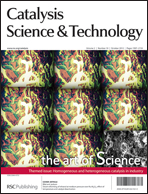Kinetic aspects and deactivation behaviour of chromia-based catalysts in hydrogen chloride oxidation
Abstract
The gas-phase HCl oxidation was studied over bulk and supported Cr2O3-based catalysts by means of kinetic experiments in a fixed-bed reactor at ambient pressure and variable temperature, inlet O2/HCl ratio, and contact time. Cr2O3 exhibited high activity for Cl2 production. X-ray diffraction of the used catalysts detected no phase change. Temperature-programmed reduction with hydrogen and X-ray photoelectron spectroscopy showed that the surface of the fresh catalyst contains chromium species in oxidation state (III) as well as higher oxidation states (V and VI) while that of the used sample features the reduction of Cr5+/Cr6+ and comprises a little amount of chlorine. Coupling the catalytic and characterisation data over Cr2O3 with activity tests over CrO3, a redox cycle is proposed in which chromium species shift between Cr3+ and Cr5+ + Cr6+. The positive dependence of the HCl conversion on the inlet O2 concentration suggests that catalyst re-oxidation is rate limiting. SiO2 was identified as a better carrier for Cr2O3 than Al2O3 and TiO2-anatase, as it favours the formation of Cr2O3 nanoparticles rather than (unstable) isolated chromate species. However, all the supported catalysts suffered from severe deactivation due to substantial chromium loss. The deactivation mechanism is assigned to the in situ formation of the highly volatile CrO2Cl2 from Cr6+ species and CrO2(OH)2 from both Cr3+ and Cr6+ species. The deactivation rate can be reduced, though not suppressed, by applying a high O2 excess in the feed mixture, thus indicating that the deactivation route via the oxychloride might be predominant. The features observed represent critical reasons justifying the restricted industrial implementation of chromium-based catalysts for HCl oxidation.

- This article is part of the themed collection: Homogeneous and heterogeneous catalysis in industry

 Please wait while we load your content...
Please wait while we load your content...